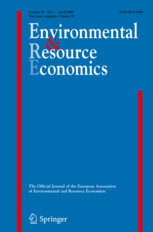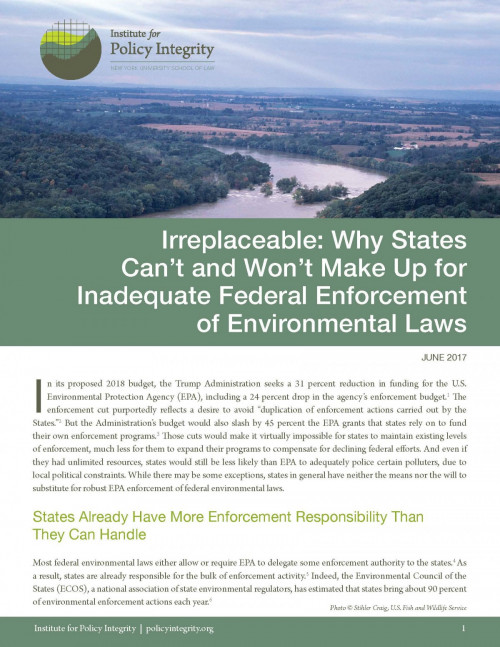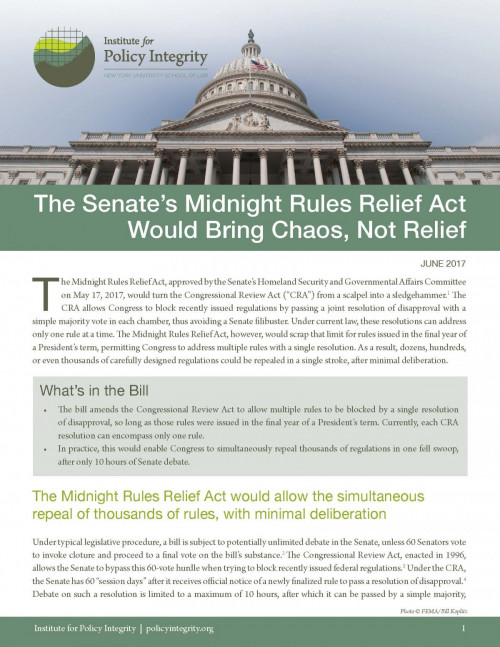-
Comments to the Department of Energy on Regulatory Burden
Following an Executive Order on reducing federal regulatory burden, the Department of Energy (DOE) is requesting the public’s suggestions for rules to repeal or reform. In our comments to DOE’s request for information, we argue that regulatory review should consider the public benefits of regulation, not just the costs to regulated industries.
-
Public Comments on Regulatory Review (HUD, MCSAC, FMC, NOAA, Coast Guard)
Many federal agencies are requesting the public’s suggestions for rules to repeal or reform, tacitly implying that most regulations stifle economic growth. In comments to several agencies, we argue that regulatory review should consider the public benefits of regulation, not just the costs to regulated industries, and should prioritize review of rules for which actual costs and benefits diverge significantly from predicted costs and benefits.
-
Comments on EPA’s Proposal to Issue a Second Stay of the Effluent Rule
Policy Integrity has filed comments opposing EPA’s proposal to issue a second stay of the compliance deadlines in the Effluent Rule—a rule that regulates toxic metal discharges from power plants. As we explained in our comments to EPA, EPA has no legal authority for the proposed stay. In addition, EPA failed to provide a reasoned explanation for the stay because it ignored the impact that the stay will have on the benefits of the Effluent Rule.
-
Comments to California’s Public Utilities Commission on Energy Planning
We recently submitted comments to California’s Public Utilities Commission, focused on the economic analysis used in its longer-term energy planning process across utilities. We ask the Commission to exercise caution in coordinating or consolidating this planning with other energy-related proceedings, as different proceedings have different goals and statutory requirements.
-
Challenging EPA’s Effluent Rule Suspension
EPA has suspended the compliance deadlines in a regulation on power plant wastewater discharges, which limits plants from releasing certain toxic metals into lakes and rivers. We submitted a “friend of the court” brief in the legal challenge to the suspension. Our brief argues that the decision to suspend the rule was arbitrary and capricious because EPA focused only on amorphous compliance costs and ignored the effects of pollution that will continue to be discharged while the rule is suspended. As we explain in the brief, it is fundamentally irrational to make a decision based on such a one-sided analysis, and the suspension should be vacated.
-
Comments to the Forest Service on Quantifying and Monetizing Greenhouse Gas Emissions
We recently submitted comments to the United States Forest Service on a Draft Environmental Impact Statement (EIS) that makes problematic claims about evaluating greenhouse gas emissions. In the Pine Mountain Late-Successional Reserve Habitat Protection and Enhancement Project Draft EIS, the Forest Service gives three main reasons for not quantifying—or monetizing the effects of—greenhouse gas emissions from the proposed action. First, the Service claims that “project level emissions alone are not sufficient to cause climate change.” Second, the Service claims that the “large majority of Forest Service projects” are too “small” for it to be “presently possible to conduct quantitative analysis of actual climate change effects.” Finally, the Service questions whether “such disclosure would provide a practical or meaningful effects analysis for project decisions.” We explain why each of these reasons is wrong according to economic principles, the requirements of the National Environmental Policy Act, and the Service’s own guidance regarding climate change.
-

The One‐In, Two‐Out Executive Order Is a Zero
President Trump’s Executive Order 13,771 directs each agency to repeal at least two existing regulations before issuing a new one and imposes a regulatory budget that sets a cap on total incremental regulatory costs. In this essay, Caroline Cecot and Michael Livermore evaluate the Order against three priorities that have been adopted by prior administrations or promoted by scholars, commentators, or interest groups: (1) increasing net benefits of regulation, (2) decreasing regulatory burdens, and (3) increasing presidential control over agencies. They also compare the Order against the regulatory reform efforts in other countries.
The authors conclude that the Order is unlikely to achieve any of these goals without significant changes. They urge President Trump to scrap the Order and instead ensure that agencies engage in reasonable retrospective review of existing regulations and that the Office of Information and Regulatory Affairs has sufficient staff to oversee agency decisionmaking, among other sensible reforms.
-

Few and Not So Far Between
A Meta-analysis of Climate Damage Estimates
Given the vast uncertainty surrounding climate impacts, meta-analyses of global climate damage estimates are a key tool for determining the relationship between temperature and climate damages. Due to limited data availability, previous meta-analyses of global climate damages potentially suffered from multiple sources of coefficient and standard error bias. To address and test for these biases, we expand on previous datasets to obtain sufficient degrees of freedom to make the necessary model adjustments, including dropping duplicate estimates and including methodological variables. Estimating the relationship between temperature and climate damages using weighted least squares with cluster-robust standard errors, we find strong evidence that duplicate and omitted variable biases flatten the relationship. However, the magnitude of the bias greatly depends on the treatment of speculative high-temperature (>4 ◦C) damage estimates. Replacing the DICE-2013R damage function with our preferred estimate of the temperature–damage relationship, we find a three- to four-fold increase in the 2015 SCC relative to DICE, depending on the treatment of productivity. When catastrophic impacts are also factored in, the SCC increases by four- to five-fold.
-

Irreplaceable: Why States Can’t Make Up for Inadequate Federal Enforcement of Environmental Laws
Budget cuts threaten EPA’s ability to enforce federal environmental laws, and states have neither the means nor the will to substitute for it. Our issue brief on EPA enforcement explores the financial and political constraints that state regulators already face when implementing federal environmental laws and how the Trump Administration’s budget cuts would exacerbate these problems.
-

The Senate’s Midnight Rules Relief Act Would Bring Chaos, Not Relief
The Midnight Rules Relief Act, approved by the Senate’s Homeland Security and Governmental Affairs Committee on May 17, 2017, would turn the Congressional Review Act (“CRA”) from a scalpel into a sledgehammer. Our issue brief describes how this shift in regulatory policy would allow for quick repeals of public safeguards after only 10 hours of Senate debate and prevent similar rules from being enacted in the future.


